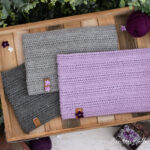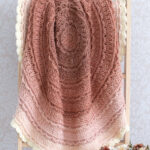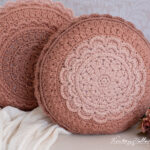You’ve run into a dilemma. You‘ve discovered some beautiful crochet design on Pinterest or Ravelry, but alas, you don’t know what the the terms are or how to read a crochet pattern, and the designer hasn’t put out a video, or step-by-step picture tutorial. What are you going to do? Mope? Of course not, because that’s not the kind of person you are, you fierce, strong, determined crochet gal, you!
This how-to guide for reading crochet patterns is going to open a whole new world to you, and I can’t wait to hear all about your crochet successes! If you’re a beginner, or new to crochet and came here to learn how to read a crochet pattern, you’re in the right place! Even if you’ve been crocheting for 20 years, and have finally decided now is the time to begin reading crochet patterns, don’t worry–I’ve got you covered.
This How-to Guide covers the following topics:
- Pattern notes and the importance of reading them first
- Anatomy of a crochet stitch
- Common US Crochet Terms and their symbols and meanings
- How to read crochet patterns parentheses and brackets
- The Difference between US and UK Crochet Terms
- A Few Words on Multiples (or how to adjust the size of the crochet pattern)
Grab a hot cup of your favorite drink, pull up a chair and get cozy (I always learn better when I’m relaxed, and chances are that you will too).
Let’s start with some crochet pattern reading basics, before we dive into the terms themselves. These are a few things I wish someone had told me when I was learning to read patterns.
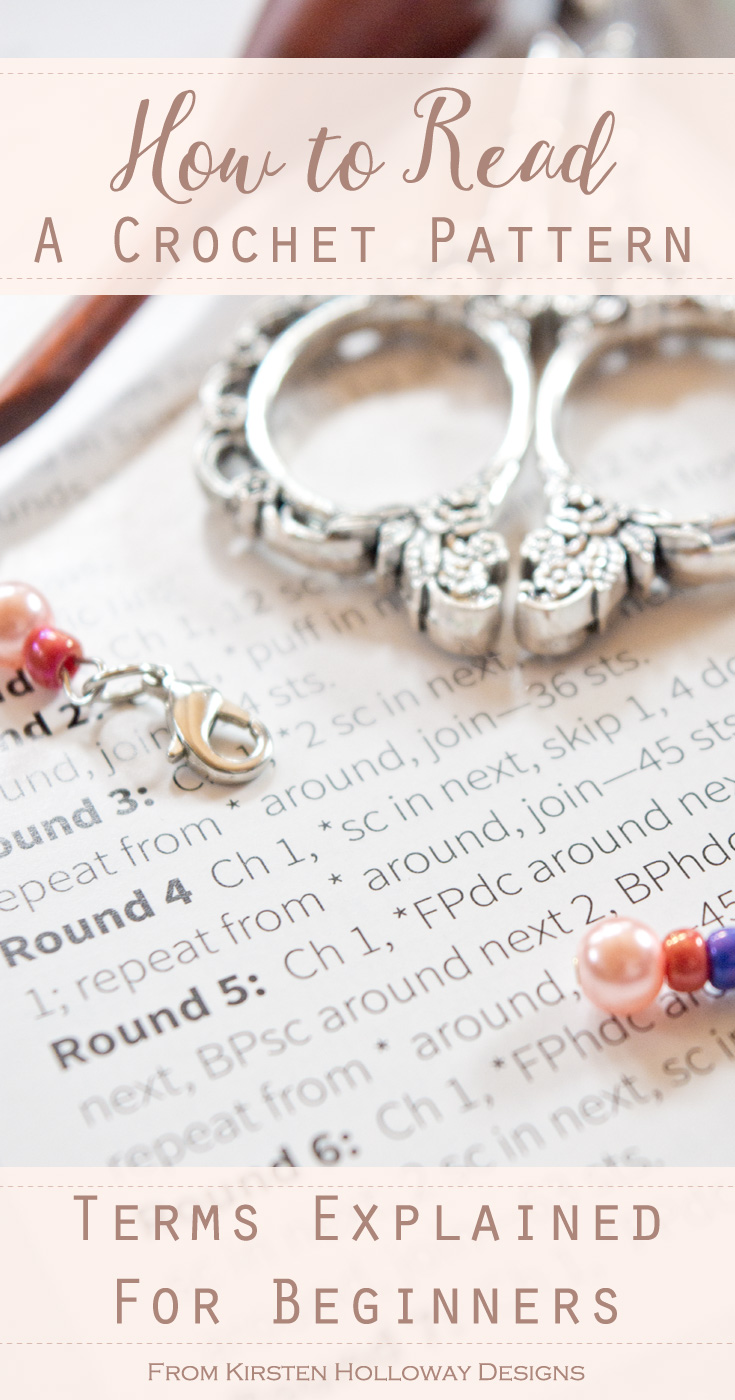
Click here if you’d like to sign up for my newsletter! It’s pressure free, filled with encouragement, crochet
tips and information, and has links to pretty patterns
It’s important to remember,
There is no right or wrong way to write a pattern
This is a source of frustration for many crocheters, but the fact is that patterns differ slightly from designer to designer, and even from magazine to magazine.* The stitch abbreviations are often the same (see the bottom of this post for differences in US vs. UK terms), but elements such as pattern repeats may be designated differently. Most reputable designers and magazines will have a crochet terms glossary at the beginning of the pattern. Look at this when in doubt.
**If you have a question about how to interpret a particular pattern, please contact the original designer. I do not have time to answer all the questions I am receiving as comments on this post. Thank you**
Becoming efficient at reading a crochet pattern takes a while
Like any skill, reading a crochet pattern will take some time to master. You may be able to crochet “Advanced” level patterns by looking at a video or picture tutorial, but grant yourself some grace if you struggle to read an “Easy” level pattern on your first try. We all have to start somewhere.
Commas are your friend
I’ll let you in on a little secret that I wish I had known when I first started out: if you’re struggling to read a crochet pattern, don’t look at the whole row or round instruction at once. Instead, take things one comma at a time.
If the pattern designer has a sequence written out such as this “sc, ch 2, sk st, sc” look at the commas, then do the step before the comma, then look for the next coma and do the step before it; little-bitty baby steps. Again, it may be frustrating if you can quickly follow a video, but if you stick with this, you’ll pick up how to read a crochet pattern in several tries.
First things first, read the pattern notes:
At the beginning of a pattern you will see several headings containing yarn, stitch, measurement, and gauge information. It is tempting to skip over these to get to the pattern, but restrain yourself, look them over, and you will likely end up saving yourself hours of frustration, and/or a ruined garment!
Skill ratings/levels:
This is how difficult an item is to crochet. There are 4 classifications: Beginner, Easy, Intermediate, and Advanced. “Beginner” patterns will often use a couple of basic stitches. “Easy” designs expand to include simple patterns made from a variety of stitches, and may include color changes and slightly more complex increases or decreases. “Intermediate” includes more difficult color work, complex stitches, or garment shaping. “Advanced” patterns may combine even more of these techniques, often in different ways, into one project.
Materials needed to complete the project:
Yarn type, and yardage, plus any notions you’ll need, such as ribbon, or buttons.
Stitches used:
A glossary of the crochet stitches you’ll need to complete the project (we’re almost to the part that will explain the terms themselves, so hang in there for just a few more minutes). Special stitches may also be listed in this section, or listed separately.
Specialty stitches:
Sometimes a pattern will have special stitches that they may not write out completely each time they show up in the pattern, as this would take too much room. Instead the designer will have the stitch mentioned in the terms glossary at the beginning of the pattern. Here are a few types that you may run into. Follow the designer’s instructions for forming these stitches as they can vary from pattern to pattern.
Puff
Shell
Bobble
V-stitch
Gauge information:
Gauge is the tension a crocheter needs to use to achieve the garment size. Making a gauge swatch is the most important, and unfortunately, the most neglected step of any crochet pattern. If you don’t want to end up frogging your entire project, and wasting valuable time (and brain cells), make a gauge swatch. You’ll thank me later. Typically, most gauges swatches are made by crocheting a square in the indicated stitch, measuring at least 4” across, by however many rows in height the designer specifies. If you crochet tightly, you may need to go up a hook size or two to match the designers gauge, inversely, if you have relaxed tension, you may need to go down a hook size or two.
Measurements:
This section will list the finished garment size or sizes.
Additional notes or assembly instructions:
Some pieces require additional instructions to put them together. This information may be listed near the top of a pattern, or near the end. Pay special attention to these sections. They will save you hours of time and frustration!
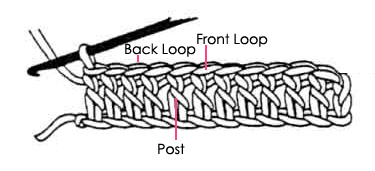
Helpful hint: Remember that a pattern is a “pattern” (remember making designs with those geometrically shaped blocks in kindergarten?) Most patterns marked “Beginner” or “Easy” will have specific (and predictable) pattern repeats or increases. For instance a hat that starts out with 12 double crochet stitches will usually increase by 12 stitches in each increase round. Likewise, a basket that starts out with 6 single crochet stitches should also increase by 6 each round. I cover stitch counts a little later on in this guide.
Anatomy of a crochet stitch:
Post – this is the main “body” of the stitch.
Front Loop – Look at the top of the stitch, and locate the sideways “V”. The front loop is the loop closest to you.
Back Loop – Look at the top of the stitch, and locate the sideways “V”. The back loop is the the loop farthest away from you.
3rd Loop/”yarn over” loop – This loop (which is the “yarn over”) is most visible at the back of the half double crochet stitch, but some patterns will ask you to work in the 3rd loop at the front. This will pop the top of the stitch forward (or backward) and make a ridge that looks knit.
Did you know? Many crochet pattern terms are acronyms!
This makes it easier to understand since “sc” stands for “single crochet”, and “hdc” stands for half double crochet. You may also see the first two letters used instead as in ch (for chain), tr (for treble crochet), or sk st (skip stitch). Patterns can be worked in rows (back and forth) or rounds. Rounds can either be joined, usually with a slip stitch, or continuous (don’t forget to use stitch markers to hold your spot!).
(Note: This guide only covers crochet terms and assumes you already have knowledge of how to crochet the most common stitches: chain, single crochet, half-double crochet, double crochet, etc. If you’re looking to learn how to crochet, you need to hop on over to YouTube and search for “learn how to crochet“. There are many good videos that will show you how.)
Common US Crochet Terms, and Abbreviations:
Once you finish reading through these terms I have included some links to a couple of easy hat patterns to help you practice the skills we just covered.
ch = chain
sp = space
ch-sp = chain space (can also be written as ch-1 sp, ch-2 sp, etc.)
sl st = slip stitch
sk st = skip stitch
sc = single crochet
hdc = half double crochet
dc = double crochet
tr = treble crochet
st/sts = stitch/stitches
tog = together
prev = previous
RS = right side
WS = wrong side
YO = yarn over
BLO/BL = back loop only (looking at the top of the stitch, you will see two “loops”. If you see this in a pattern, only work stitches in the back loop
FLO/FL = front loop only (looking at the top of the stitch, you will see two “loops”. If you see this in a pattern, only work stitches in the front loop
Magic Circle/Magic Ring = This is a special slip knot that you work your stitches in when beginning projects in the round (like hats). Here’s a link to a step-by-step picture tutorial.
You may also run into some stitches that combine terms, such as a FP (Front Post) or BP (Back Post) stitch with a dc (double crochet), hdc (half double crochet), or sc (single crochet) stitch:
FPdc = front post double crochet. Work stitch around the front of the post. Can also be FPtr, FPhdc, or FPsc.
BPdc = back post double crochet. Work stitch around the back of the post. Can also be BPtr, BPhdc, or BPsc
Decrease stitches are often written as follows: (Note: You may also see something like “dec in every 5th st” to mark a decrease in every 5th stitch.)
sc2tog = single crochet 2 together. This decrease tells you to crochet two single crochet stitches together. You may also run into sc3tog or sc4tog, etc.
dc2tog = double crochet 2 together. This is also a decrease, but with double crochet stitches. You may also see dc3tog or dc4tog, etc.
tr2tog = treble crochet 2 together. Same idea as above, but with treble crochet stitches.
CL = cluster. Similar to a bobble (described below), this is a group of stitches worked into one single stitch or space. They are worked in the same way a dc3tog or dc5tog is worked (crocheted half way before starting the next stitch) but will only be in one single stitch–they are NOT a decrease!
You may also run into special terms such as bobble, shell, picot or puff in a pattern. These should be defined by the designer at the top of the pattern. ALWAYS consult the designer’s notes to find out how the stitches are made, but in general:
Bobble = dc5tog in the same stitch. These are often, but not always followed by a single crochet that makes them bump out the front of the design.
Shell = 5 double crochet in the same stitch. Don’t confuse these with a cluster–they are 5 separate stitches that should fan out into a shell shape
Puff = yarn over, pull up a loop 4 times in same stitch, pull through all loops on your hook
Popcorn (can also be abbreviated “pc”) = 5 dc in same stitch, remove your hook from the working yarn (that loop that’s still on your hook), and put it through the top of the first dc you made, then poke your hook through that loop you dropped earlier and pull the two ends of your 5 dc together making a bit of a point at the top.
Picot = ch 3, slip stitch back into first ch. This makes a cute little bump that is most often used on the edges of lacy things.
Sometimes there are symbols in the middle of a pattern. Here are what they mean:
, = a pause between steps. If you see “ch 1, sc in next 3 sts, sk 2 sts, 5 dc in the next, sk 2 sts, sc in the next”, don’t get overwhelmed. Each comma is a place to pause before moving on to the next stitch. First, ch 1, then single crochet in the next 3 stitches, skip 2 stitches, and work 5 double crochet in the next stitch, skip 2 more stitches, and single crochet in the next stitch.
* = repeat the instructions as directed.
* to * = repeat the instructions inside the asterisks as many times as directed, or until the end of a row or round. Can also be in the middle of a row/round. Brackets [ ] or Parentheses ( ) may also be used in place of asterisks.
Try out your new skills (but don’t forget to scroll down for more pattern reading tips first!):
Here are a few easy hat patterns that you can crochet for hospitals, homeless centers, or friends and family.
- This hat pattern comes in 4 sizes. You’ll practice post stitches, and working in the back loop only (BLO).
- This hat pattern also comes in 4 sizes.You’ll practice working in the 3rd loop of a half-double crochet stitch, as well as gain experience alternating between single crochet and double crochet to create a fun texture.
- Once you master the skills above try this textured men’s beanie. Read the pattern notes to see how you can use a different hook size to make it smaller for the women in your family.
If hats aren’t something you want to jump into right away, try this beginner-friendly cowl made with chunky yarn,
- ”Sashay Around” cowl. It has pictures, and makes a great first project for kids and adults alike.
How to read crochet patterns parentheses and brackets:
Brackets may be used in a spot to tell you how many times to work the designated instructions, for example: “[dc, ch 1, sk st] 10 times” means to work the instructions in the brackets a total of 10 times before moving on to the next part of the pattern.
Parentheses often are used to tell you to work a group of stitches into one stitch, for example: “(sc, ch 2, sc)” means to work all of those stitches inside the parentheses in one single stitch before moving to the next stitch.
And, you’ll often notice numbers at the end of most well-written patterns. They may or may not be in parentheses. These are your stitch counts for the current row or round. For example, here is row 4 from my Primrose and Proper super scarf:
- Row 4: ch 3 (counts as first dc of row), turn, 2 dc in first ch-2 sp, *3 dc in next ch-2 sp; repeat from * across, in final ch-2 sp of row work only 2 dc, dc in top of ch-2 from prev row. (300 [192, 228])
The numbers at the end show the stitch count for the instructions as written (300), then it also shows two other counts if you want to make the scarf in different lengths [192] and [228]. When making garments you may see 4 or 5 different numbers at the end of each row. Each of these numbers is for a different size. Usually it will go (small, medium, large, XL, XXL), so if you’re making a “medium” just make sure your counts are always matching up with the 2nd number from the left. The designer should note the sizes beforehand to make it clearer (this is another reason to read the information at the beginning of a pattern).
The Difference between US and UK Crochet Terms
If you are in the US and follow a pattern from a UK designer, you will quickly notice some differences in terms!
There is no “sc”, but you will see htr and dtr, so what do these mean?
Some basic US terms, and their UK equivalent:
sc = dc
hdc = htr (half treble crochet)
dc = tr
tr = dtr (double treble)
If you want a more comprehensive list of US/UK terms, head on over to the Craft Yarn Council’s website, and check out their list.
A Few Words on Multiples
This is a slightly more advanced technique, but one that I wish I had known more about when I first started crocheting, so I’m including it here in the hope that it will help you too.
Sometimes you will run across a scarf or afghan pattern with the note “worked in multiples of 6 + 2” or something similar. This is helpful because with this information you can size the pattern up or down based on your needs! All you need to do is find the gauge, then do some simple multiplication, then add the required number of “extra” stitches (in this example, 2). If you had a queen-sized afghan that you wanted to make into a baby blanket, and it was written in multiples of 6 + 2, you would first find the gauging information. Let’s say, for example it’s 12 dc stitches in 4”. You will take that number (12) and multiply it by 3 to find out how many stitches are in 1 foot/12 inches (12 x 3=36). Once you know how many stitches are in a foot (36 in our case), you can multiply that number by the number of feet (in width or height) that you need your baby blanket to be. I’ll use 3 ft as an example: 36 x 3=108. So, your starting row needs to have 108 chains (conveniently, 108 is a multiple of 6), plus 2 more chains, for a total of 110. It is important to note that some people include the turning chain in this multiple count, and others do not. Most of the time it should be included.
Thank you so much for stopping in today! If you enjoyed this article, please consider following me on Facebook, Pinterest, Instagram, and Ravelry for more crochet tips and tricks. as well as free crochet patterns.
*This is where we practice being flexible–like a piece of yarn!
.
.
.
Umm, ok…Can someone help me out of the tangle I’m in? Anyone?


